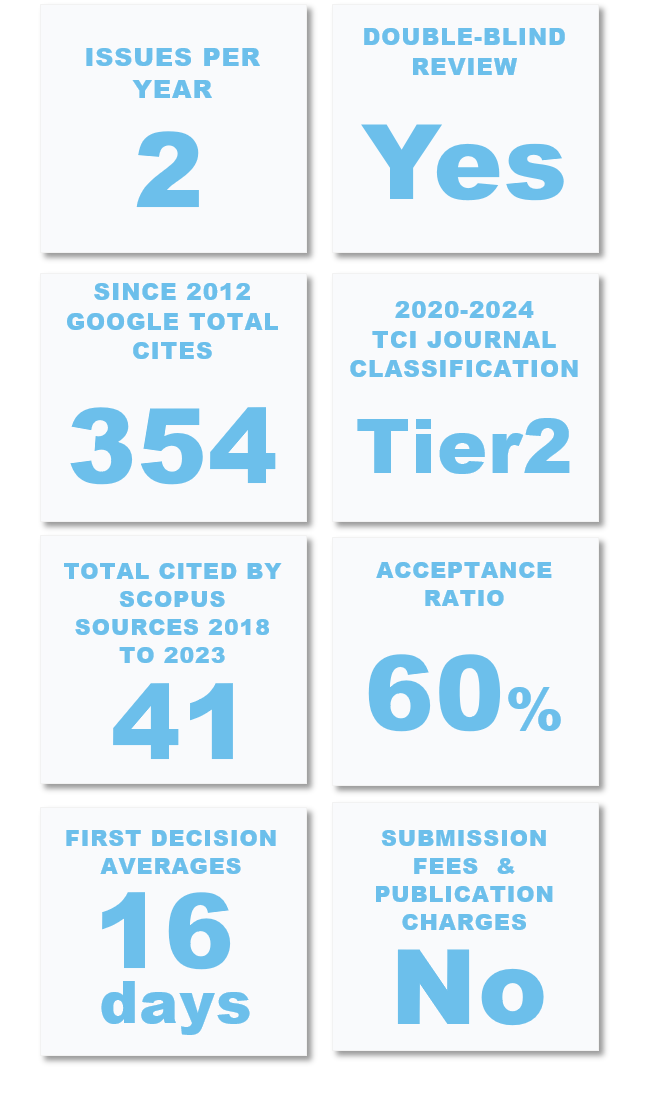Theoretical Concepts of Crime and Practices in Urban Planning and Design Process for Safe Urban Life
Keywords:
Crime prevention, Safe urban life, Urban crime theory, Urban design, Urban planningAbstract
Crime is a serious concern from the very beginning of human civilization and several theoretical concepts are addressing the ‘social crime’ issue minimization crime without compromising harmonized economic activities and environmental safety. However, urbanization is very closely associated with social crime, for example, rapid urbanization which includes architectural planning accommodating housing and transportation, level of accessibility and other outdoor spaces can influence crime and fear of delinquency to the city dwellers. This review explored the relationship between crime and urbanization from the existing theoretical concepts of crime in urban planning, design and development viewpoints. We also discussed the applications of theoretical concepts in urban planning processes to minimize the crime and its possible prevention strategies. More precisely, place-based theoretical concepts of crime depict the urban socio-physical environment with socially disorganized locations of the city and the causes of social disorder and pave a way for the local government to take and implement strategic plans for ensuring good governance of the city. These concepts also demonstrate crime pattern, hotspots formation, causes-effects and how to prevent crime hotspots. Thus, taking these concepts into consideration, a significant portion of crime can be reduced in modern planned urbanization. Besides, continuous refinement of 1st, 2nd, and 3rd generation concepts of crime prevention through environmental design (CPTED) is worth considering in urban planning and design process preventing crime and safe urban environment initiative. Finally, further studies are needed to comprehend crime avoidance actions in urban planning and design process for safe urban life, particularly in developing countries.
Downloads
References
Boessen, A., Hipp, J. R., Butts, C. T., Nagle, N. N., & Smith, E. J. (2016). Social fabric and fear of crime: Considering spatial location and time of day. Social Networks, 51, 60-72.
Chowdhury, D. (2014). Crime prevention through urban planning: A case study on Ramna Thana. Savar, Dhaka: Jahangirnagar University.
NSW Department of Urban Affairs and Planning. (2001).Crime prevention and the assessment of development applications Guidelines under section 79C of the Environmental Planning and Assessment Act 1979. Retrieved from http://www.police.nsw.gov.au/data/assets/pdf_file/0003/9390/duapguide_s79c.pdf.
New Zealand Ministry of Justice. (2009). Strategic policy brief: Theories of the causes of crime. New Zealand: Author.
Series, A., Rounds, I. G., & Commissions, A. (2012). Shaping cities for health: Complexity and the planning of urban environments in the 21st Century. The Lancet, 379(9831), 2079-2108.
Sundukovskiy, S. (2014). From prototype to MVP (case study). Retrieved from https://www.slideshare.net/ssunduko/from-prototype-to-mvp-case-study , Accessed on 8 May 2017.
Suryavanshi, V. M. (2001). Land use and opportunities for crime: Using GIS as an analysis tool. (Doctoral dissertation). Virginia Polytechnic Institute, and State University.
United Nations Office on Drugs and Crime. (2015). World Drug Report 2015. United Nations New York: Author.
Weatherburn, D. (2001). What causes crime? BOCSAR NSW Crime and Justice Bulletins, 11. Sydney: NSW Bureau of Crime Statistics and Research.
Western Australian Planning Commission. (2006).Designing out crime planning guidelines. Perth, Australia: Western Australian Planning Commission.
Agbola, T. (1997). The architecture of fear: Urban design and construction response to urban violence in Lagos, Nigeria. Retrieved May 20, 2018 from http://books.openedition.org/ifra/485.
Akers, R. L., & Sellers, C. S. (2013). Student study guide for criminological theories: Introduction, evaluation, application. New York, Oxford: Oxford University Press.
Alkimim, A., Clarke, K. C., & Oliveira, F. S. (2013). Fear, crime, and space: The case of Viçosa, Brazil. Applied Geography, 42, 124-132.
Andresen, M. A. (2016). The place of environmental criminology within criminological thought. In Classics in environmental criminology (pp. 21-44). CRC Press.
Anselin, L., Cohen, J., Cook, D., Gorr, W., & Tita, G. (2000). Spatial analyses of crime. Criminal justice, 4(2), 213-262.
Asl, H. B., Moghadam, H. Z., & Parhiz, F. (2014). Analysis of spatial patterns for urban crimes in the informal settlement area of Islamabad in Zanjan. International Journal of Academic Research in Business and Social Sciences, 4(4), 1-9.
Australian Institute of Criminology. (2012). National crime prevention framework. Retrieved from http://www.aic.gov.au/crime_community/crimeprevention/ncpf.html.
Bdward, J., Pesce, I. R. K., & Howard, M. K. (1976).Crime prevention through environmental design (Final Report). Virginia, US: Department of Justice.
Becker, G. S. (1968). Crime and punishment: An economic approach. The economic dimensions of crime (pp. 13- 68). UK: Palgrave Macmillan.
Bernasco, W. (2014). Crime journeys: Patterns of offender mobility. In M. Tonry (Ed.),Oxford handbooks online in criminology and criminal justice. Oxford, UK: Oxford University press. DOI: 10.1093oxfordhb/9780199935383.013.49.
Briggs, R. (2010). Spatial autocorrelation: The single most important concept in geography and GIS! introduction to concepts. Dallas, USA: Henan University.
Brown, N. (2005). Robert park and ernest burgess: Urban ecology studies, 1925. CA: Center for Spatially Integrated Social Science (CSISS).
Brantingham, P., & Brantingham, P. (1993). Nodes, paths, and edges: Considerations on the complexity of crimeand the physical environment. Journal of Environmental Psychology, 13(1), 3-28. DOI: 10.1016/S0272-4944(05)80212-9.
Brunton-Smith, I., & Jackson, J. (2011). Urban fear and its roots in place. In C. Vania (Ed.),The urban fabric of crime and fear (pp. 55-82). Germany: SpringerNetherlands Press.
Bourguignon, F. (2001). Crime as a social cost of poverty and inequality: A review focusing on developing countries’, manuscript. Washington, DC: World Bank. Retrieved from http://poverty.WorldBank.org/library/view/13480.
Burgess, M. (2011). Understanding crime hotspot maps. Sydney, Australia: NSW Bureau of Crime Statistics and Research.
Cahill, M. E. (2004). Geographies of urban crime: An intra- urban study of crime in Nashville, Tennessee; Portland, Oregon; and Tucson, Arizona. Arizona, USA: The University of Arizona.
Ceccato, V. (Ed.). (2012). The urban fabric of crime and fear. New York: Springer.
Chainey, S., & Ratcliffe, J. (2005). Mastering GIS: Technology, applications, and management. West Sussex, England: John Wiley& Sons.
Clarke, R. V. G., & Mayhew, P. (1980). Designing out crime. UK: HMSO Books.
Christens, B., & Speer, P. W. (2005). Predicting violent crime using urban and suburban densities. Behavior and Social Issues, 14(2), 113.
Clarke, R. V. (Ed.) (1993). Situational crime prevention: successful case studies. Guilderland, New York: Harrow and Heston.
Cohen, L. E., & Felson, M. (1979). Social change and crime rate trends: A routine activity approach. American sociological review, 44(4), 588-608.
Cornish, D. B., & Clarke, R. V. (1987). Understanding crime displacement: An application of rational choice theory. Criminology, 25(4), 933–948. DOI: 10.1111/J.1745- 9125.1987.Tb00826.
X.Covington, J., & Taylor, R. B. (1991). Fear of crime in urban residential neighborhoods. The Sociological Quarterly, 32(2), 231-249.
Cozens, P. M, Saville, G., & Hillier, D. (2005). Crime prevention through environmental design (CPTED): A review and modern bibliography. Property management, 23(5), 328-356.
Cozens, P. (2007). Planning, crime, and urban sustainability.WIT Transactions on Ecology and the Environment, 102, 187-193.
Cozens, P. (2008). Crime prevention through environmental design in Western Australia: Planning for sustainableurban futures. International Journal of Sustainable Development and Planning, 3(3), 272-292.
Cozens, P. M. (2011). Urban planning and environmental criminology: Towards a new perspective for safer cities. Planning practice and research, 26(4), 481-508.
Crowe, T. (1991). Crime prevention through environmental design: Application of architectural design and space management concepts. Boston, Mass.: Butterworth- Heinemann.
Crowe, T. D. (2000). Crime prevention through environmental design: applications of architectural design and space management concepts (2 nd. ed.). Oxford, United Kingdom: Butterworth-Heinemann.
Davies, W. K. D. (2004). Affective dimensions of urban crime areas: Towards the psycho-geography of urbanproblem areas. Geographica Helvetica, 218-226.
Department of Attorney General and Justice. (2011).Environmental criminology and crime prevention. Sydney, Australia: NSW Attorney General’s Department.
Doran, B. J., & Lees, B. G. (2005). Investigating the spatiotemporal links between disorder, crime, and the fear of crime. The Professional Geographer, 57(1), 1-12.
Eck, J. E., & Weisburd, D. L. (2015). Crime places in crime theory. Crime and place: Crime prevention studies, 4,1-33.
Erdogan, A. (2010). What do place-based crime prevention strategies mean for the Turkish planning system and urban transformation. Journal of Geography and Regional Planning, 3(11), 271.
Felson, M., & Clarke, R. V. (1998). Opportunity make the thief: Practical theory for crime prevention (Police Research Series Paper 98). London: Research, Development and Statistics.
Gardiner, R. A. (1978). Design for safe neighborhoods: The environmental security planning and design process. Washington, U.S.A: National Institute of Law Enforcement and Criminal Justice.
Gibson, V. L. (2016). Third generation CPTED? rethinking the basis for crime prevention strategies. (Doctoral dissertation). Department of Geography and Environment, Northumbria University.
Glick, L. (2005). Criminology. Portland, ME, U.S.A.: Allyn & Bacon.
Green, S. L. (2002). Rational choice theory: An overview. Texas, USA: Department of Economics, Baylor University.
Gul, S. K. (2009). An evaluation of the rational choicetheory in criminology. Girne American University Journal of Social and Applied Science, 4(8), 36-44.
Harcourt, B. E., & Ludwig, J. (2006). Broken windows: New evidence from New York City and a five-city social experiment. The University of Chicago Law Review, 73, 271-320.
Harcourt, B. (2002). Policing disorder: Can we reduce serious crime by punishing petty offenses. Boston Review, 27(2), 17-18.
Heidt, J. M. (2011). The evolution of criminological theories. (Doctor dissertation). Faculty of Arts and Social Sciences, School of Criminology, Simon Fraser University.
Hiropoulos, A., & Porter, J. (2014). Visualising property crime in gauteng: Applying GIS to crime pattern theory. SA Crime Quarterly, 47(1), 17-28.
Holzman-Escareno, A. (2015). English 215 final project: The cause of crime. Retrieved from https://hilo.hawaii.edu/academics/hohonu/documents/Vol07x03TheCauseofCrime.pdf.
Irvin-Erickson, Y. (2014). Identifying risky places for crime: An analysis of the criminogenic spatiotemporal influences of landscape features on street robberies. (Doctoral dissertation). Graduate School-Newark Rutgers, The State University of New Jersey.
Jacobs, J. (1961). The death and life of great American cities. New York: Vintage.
Jalil, H. H., & Iqbal, M. M. (2010). Urbanization and crime: A case study of Pakistan. The Pakistan Development Review, 49(4), 741-755.
Jefferson, B. J. (2015) Enforceable Environment: Spaces of Policing, Sustainability, and Environmental Rhetoric’. In D. Wilson (Ed.), The politics of the urban sustainability concept. Illinois, USA: Common Ground Publishing.
Jones, I., & Bartlett Learning, L. L. C. (2014). Comparative criminal justice: Theoretical perspectives. In H. Kamalipour, M. Faizi & G. Memarian, Safe place by design: Urban crime in relation to spatiality and sociality, Current Urban Studies, 2(2), 152-162.
Kamalipour, H., Memarian, G., & Faizi, M. (2014). Urban crime, and pattern conceptions: departuring from spatiality. Open Journal of Social Sciences, 2(6), 441- 450.
Khopolklang, N., Polnigongit, W., & Chamnongsri, N. (2014). Influence of the Thai mass media on violence against women: Synthesis of research studies. Kasetsart Journal: Social Sciences, 35(1), 167-176.
Koper, C. S., Egge, S. J., & Lum, C. (2015). Institutionalizing place-based approaches: Opening ‘Cases’ on gun crime hot spots. Policing, 9(3), 242-254.
Kubrin, C. E. (2009). Social disorganization theory: Then, now, and in the future. In D. Marvin, Krohn, J. Alan, Lizotte, & P. Gina, Hall (Eds.),Handbook on crime and deviance (pp. 225-236). New York, USA: Springer.
Kubrin, C. E., & Weitzer, R. (2003). New directions in social disorganization theory. Journal of research in crime and delinquency, 40(4), 374-402.
Levald, A., Sibul, J. J., Proosa, M., Klein, M., Lehtovuori, P., van Soomeren, P., ... and Paaver, T. (2016). CPTED manual for police officers. USA: Police and Border Guard Board.
Marzbali, M. H., Abdullah, A., Razak, N. A., & Tilaki, M. J. M. (2011). A review of the effectiveness of crime prevention by design approach towards sustainable development. Journal of Sustainable Development, 4(1), 160.
Matsueda, R. L. (2013). The macro-micro problem incriminology revisited. The Criminologist, 38(1), 3-6.
Mega, V. (1996). Our city, our future: towards sustainable development in European cities. Environment and Urbanization, 8(1), 133-154.
Meinen, T. (2014). Neighborhood disorder, crime, and the broken windows theory: An examination of the relationship between neighborhood disorder and crime in the city districts of Rotterdam. Enschede, Netherlands: University of Twente.
Mors, A., Isacson, A., & Meyer, M. (2011). Tackling urban violence in latin America: Reversing exclusion through smart policing and social investment. Washington, DC: Washington Office on Latin America.
Moskos, P. C. (2016). Broken windows: Is there a link between police, disorder, fear, and crime?. New York: John Jay College of Criminal Justice.
Newman, O. (1972). Creating defensible space. Pennsylvania, USA: Diane Publishing.
Parliament of Victoria. (2013). Inquiry into the application of safer design principles and crime prevention through environmental design. Victoria, Australia: Drugs and Crime Prevention Committee.
Randa, R. (2014). Environmental criminology, The encyclopedia of criminology, and criminal justice. New Jersey, USA: Blackwell Publishing.
Rindlisbacher, R. (2014). Juvenile crime and urban planning– How to measure crime factors and promote prevention by using geospatial technologies? (Final Report – Marshall Plan Foundation). Graz, Australia:University of Graz.
Sanidad-Leones, C. (2006) The current situation of crime associated with urbanization: problems experienced and countermeasures initiated in the Philippines.Resource Material Series, 68, pp.133-150.
Santana, P., Santos, R., Costa, C., Roque, N., & Loureiro, A. (2009). Crime and urban environment: Impact onhuman health. City futures in a globalising world: an international conference on globalism and urban change. Madrid, Spain.
Saville, G., & Cleveland, G. (1997). 2nd generation CPTED: an antidote to the social Y2K virus of urban design. In 2nd Annual International CPTED Conference, Orlando, FL (pp. 3-5).
Schiller, J., Black, W., & Murphy, P. V. (2010). Crime and criminality. Retrieved from http://www.des.ucdavis.edu/faculty/Richerson/BooksOnline/He16-95.pdf.
Scott, J. (2000). Rational choice theory. In G. Browning, A. Halcli, & F. Webster (Eds.), Understanding contemporary society: Theories of the present (pp. 126-138). London: Sage Publications. DOI: 10.4135/9781446218310.n9.
Shamsuddin, S. B., & Hussin, N. A. B. (2013). Safe city concept and crime prevention through environmental design (CPTED) for urban sustainability in Malaysian cities. American Transactions on Engineering & Applied Sciences, 2(3), 223-245.
Shaw, M., & Carli, V. (2011) Practical Approach to Urban Crime Prevention. Proceedings of the Workshop held at the 12th UN Congress on Crime Prevention and Criminal Justice. Salvador, Brazil: International Centre for the Prevention of Crime.
Sherman, L. W. (1995). Hot spots of crime and criminalcareers of places. Crime and place, 4, 35-52.
Shukla, A. B. (2015). Validating the theories of urbancrime in the city of raipur. IOSR Journal of Engineering (IOSRJEN), 5(1), 15-24.
Siegel, L. J. (2014). Criminology: The Core (5th ed.). California, USA: Wadsworth Publishing.
Skogan, W. G. (2008). Broken windows: Whyandhowwe should take them seriously. Criminology and Public Policy, 7(2), 195-201.
Soomeren, P. V. (2013). A set of European CPTED standards for secure cities-safe and secure cities through urban design, and planning: standardizing the process. Amsterdam, The Netherlands: European Designing Out Crime Association.
Spinks, C. (2001). A new apartheid?: Urban spatiality,(fear of) crime, and segregation in cape town, South Africa. London, UK: Development Studies Institute, London School of Economics and Political Science.
Siegal, L. L. (2006). Chapter 6: Social structure theory. California, USA: Wadsworth Thomson Publishing. Retrieved from http://www.loyno.edu/~Thornton/Spring06/PPT_Lectures/chapter6.ppt.
The Scottish Centre for Crime and Justice Research. (2016).Theories and causes of crime. Retrieved from: http://www.sccjr.ac.uk.
Trimek, J. (2014). Urban crime in western and eastern societies (Chicago, London, and Bangkok). Rangsit Journal of Social Sciences and Humanities, 1(1), 69-80.
Troy, A., Nunery, A., & Grove, J. M. (2016). The relationship between residential yard management and neighborhood crime: An analysis of Baltimore cityand county. Landscape and Urban Planning, 147, 78-87.
UN-Habitat. (2007a). Enhancing urban safety and security-global report on human settlements 2007. London, UK: United Nations Human Settlements Program.
UN-Habitat. (2007b). Crime and violence at a Glance (Global Report on Human Settlements 2007). London, UK: United Nations Human Settlements Program.
United Nations. (2015). Thirteenth United Nations congress on crime prevention and criminal justice, State of crime and criminal justice worldwide (Report of the Secretary-General). Doha, Qatar: Author.
Warissara, S. (2015). Subculture of inmates in Thai prisons. Kasetsart Journal of Social Sciences, 36, 109 – 118.
Weisburd, D. (2008). Place-Based policing. In Ideas inAmerican Policing. Police foundation, 9, 1-16.
Weisburd, D. L., & Telep, C. W. (2015). The efficiency ofplace-based policing. Hebrew University of Jerusalem Legal Research Paper, 15-26. DOI: 10.2139/ssrn.2630 369.
Weisburd, D. L., Telep, C. W., & Braga, A. A. (2015). The importance of place in policing: Empirical evidence and policy recommendations. Stockholm, Sweden: Brå–a center of knowledge on crime and measures tocombat crime.
Weisburd, D., & Gill, C. (2014). Block randomized trials at places: rethinking the limitations of small N experiments. Journal of Quantitative Criminology, 30(1), 97-112.
Wilson, J. Q., & Kelling, G. L. (1982). Broken windows.Atlantic Monthly, 249(3), 29-38.
Wortley, R., & Mazerolle, L. (Eds.). (2013). Environmental criminology, and crime analysis. UK: Willan Publishing.
Zahm, D. (2007). Using crime prevention through environmental design in problem-solving (Problem- oriented guides for police, Problem-solving tools series 8). Washington, D.C., USA: U.S. Department of Justice.

Downloads
Published
How to Cite
Issue
Section
License

This work is licensed under a Creative Commons Attribution-NonCommercial-NoDerivatives 4.0 International License.











